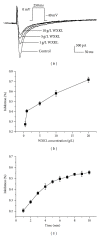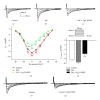Effects of wenxin keli on the action potential and L-type calcium current in rats with transverse aortic constriction-induced heart failure
- PMID: 24319478
- PMCID: PMC3844239
- DOI: 10.1155/2013/572078
Effects of wenxin keli on the action potential and L-type calcium current in rats with transverse aortic constriction-induced heart failure
Abstract
Objective. We investigated the effects of WXKL on the action potential (AP) and the L-type calcium current (I Ca-L) in normal and hypertrophied myocytes. Methods. Forty male rats were randomly divided into two groups: the control group and the transverse aortic constriction- (TAC-) induced heart failure group. Cardiac hypertrophy was induced by TAC surgery, whereas the control group underwent a sham operation. Eight weeks after surgery, single cardiac ventricular myocytes were isolated from the hearts of the rats. The APs and I Ca-L were recorded using the whole-cell patch clamp technique. Results. The action potential duration (APD) of the TAC group was prolonged compared with the control group and was markedly shortened by WXKL treatment in a dose-dependent manner. The current densities of the I Ca-L in the TAC group treated with 5 g/L WXKL were significantly decreased compared with the TAC group. We also determined the effect of WXKL on the gating mechanism of the I Ca-L in the TAC group. We found that WXKL decreased the I Ca-L by accelerating the inactivation of the channels and delaying the recovery time from inactivation. Conclusions. The results suggest that WXKL affects the AP and blocked the I Ca-L, which ultimately resulted in the treatment of arrhythmias.
Figures






Similar articles
-
Antiarrhythmic effects and potential mechanism of WenXin KeLi in cardiac Purkinje cells.Heart Rhythm. 2016 Apr;13(4):973-82. doi: 10.1016/j.hrthm.2015.12.023. Epub 2015 Dec 14. Heart Rhythm. 2016. PMID: 26699239
-
Wenxin Keli diminishes Ca2+ overload induced by hypoxia/reoxygenation in cardiomyocytes through inhibiting INaL and ICaL.Pacing Clin Electrophysiol. 2017 Dec;40(12):1412-1425. doi: 10.1111/pace.13206. Epub 2017 Nov 16. Pacing Clin Electrophysiol. 2017. PMID: 28972668
-
Effects of Wenxin Keli on Cardiac Hypertrophy and Arrhythmia via Regulation of the Calcium/Calmodulin Dependent Kinase II Signaling Pathway.Biomed Res Int. 2017;2017:1569235. doi: 10.1155/2017/1569235. Epub 2017 May 9. Biomed Res Int. 2017. PMID: 28573136 Free PMC article.
-
[Transmural L-type calcium current in a pressure-overloaded mouse model with heart failure].Sheng Li Xue Bao. 2007 Feb 25;59(1):19-26. Sheng Li Xue Bao. 2007. PMID: 17294038 Chinese.
-
Therapeutic Effects of Wenxin Keli in Cardiovascular Diseases: An Experimental and Mechanism Overview.Front Pharmacol. 2018 Sep 5;9:1005. doi: 10.3389/fphar.2018.01005. eCollection 2018. Front Pharmacol. 2018. PMID: 30233380 Free PMC article. Review.
Cited by
-
Molecular Targets and Pathways Contributing to the Effects of Wenxin Keli on Atrial Fibrillation Based on a Network Pharmacology Approach.Evid Based Complement Alternat Med. 2020 Oct 7;2020:8396484. doi: 10.1155/2020/8396484. eCollection 2020. Evid Based Complement Alternat Med. 2020. PMID: 33123211 Free PMC article.
-
The Effect of Wenxin Keli on the mRNA Expression Profile of Rabbits with Myocardial Infarction.Evid Based Complement Alternat Med. 2016;2016:2352614. doi: 10.1155/2016/2352614. Epub 2016 Oct 24. Evid Based Complement Alternat Med. 2016. PMID: 27843475 Free PMC article.
-
The Role of Biologically Active Ingredients from Natural Drug Treatments for Arrhythmias in Different Mechanisms.Biomed Res Int. 2017;2017:4615727. doi: 10.1155/2017/4615727. Epub 2017 Apr 11. Biomed Res Int. 2017. PMID: 28497050 Free PMC article. Review.
-
The Efficacy and Safety of Wenxin Keli in Patients with Frequent Premature Ventricular Contractions: A Randomized, Double-blind, Placebo-controlled, Parallel-group, Multicenter Trial.Chin Med J (Engl). 2015 Oct 5;128(19):2557-64. doi: 10.4103/0366-6999.166026. Chin Med J (Engl). 2015. PMID: 26415790 Free PMC article. Clinical Trial.
-
Identification of Lauric Acid as a Potent Sodium Channel NaV1.5 Blocker from Compound Chinese Medicine Wenxin Keli.Drug Des Devel Ther. 2025 Jan 9;19:141-157. doi: 10.2147/DDDT.S485723. eCollection 2025. Drug Des Devel Ther. 2025. PMID: 39807341 Free PMC article.
References
-
- Roger VL, Go AS, Lloyd-Jones DM, et al. Executive summary: heart disease and stroke statistics-2012 update: a report from the American heart association. Circulation. 2012;125(1):188–197. - PubMed
-
- Maron BJ, Doerer JJ, Haas TS, Tierney DM, Mueller FO. Sudden deaths in young competitive athletes analysis of 1866 deaths in the united states, 1980–2006. Circulation. 2009;119(8):1085–1092. - PubMed
-
- Bers DM. Calcium cycling and signaling in cardiac myocytes. Annual Review of Physiology. 2008;70:23–49. - PubMed
-
- Eisner DA, Kashimura T, Venetucci LA, Trafford AW. From the ryanodine receptor to cardiac arrhythmias. Circulation Journal. 2009;73(9):1561–1567. - PubMed
LinkOut - more resources
Full Text Sources
Other Literature Sources
Miscellaneous

